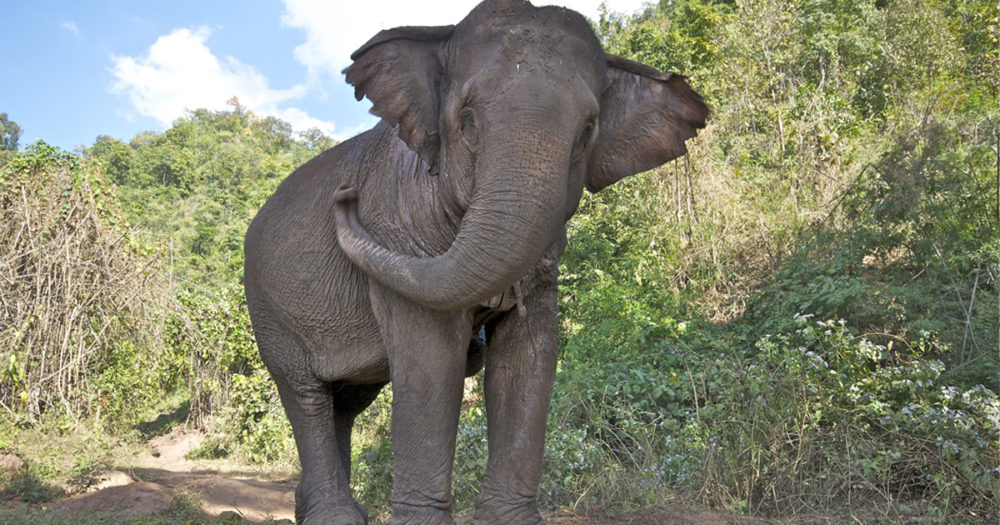It’s 16:30 in rural Myanmar and my field crew, who had spent the day surveying for elephant dung, are racing our caravan of motorbikes back to the field camp before dusk descends. As the day fades tempering the oppressive heat, elephants emerge from the shade of the forest to begin foraging, sometimes in the sugarcane and rice paddies that are increasingly spreading across the country. Running into one of these giants as they too use the network of dirt roads to travel through the landscape can be fatal, necessitating a strict policy of returning to camp before dark for the safety of the team. While my field season lasts a short three months, this is one of many concessions residents are forced to make or risk their lives encountering an elephant as night falls.

A large chunk of elephant skin
It is unsurprising that most of the remaining endangered charismatic mega fauna are in some of the poorest areas on earth. It is in these areas where wildlands still exist, and the lack of economic development has prevented the boom of industry and infrastructure that could spell the end for remaining mega herbivores and carnivores. It is also in these areas where the people tasked with the burden of living with the species disproportionately bear the brunt of human-wildlife conflict. Though local community members indicate they value elephants for religious and cultural reasons, as well as the important role they play in the ecosystem, increasing human-elephant conflict may lead to a greater acceptance of elephant poaching as a way to prevent crop-raiding and reduce human injury and death from run-ins with their giant neighbors.
I began using satellite-GPS collars to monitor elephant movements in 2015 with the hope of using this data to inform conservation policy and develop ways to mitigate human-elephant conflict. Instead, these collars turned into beacons that allowed us to locate the carcasses of the elephants after they had been killed by poachers. Further groundwork revealed an astounding rate of elephant poaching occurring throughout Myanmar. And what’s more, poachers aren’t just killing elephants for their ivory- elephant skin, genitals, and other parts are increasingly being sought after for export into neighboring countries such as China.
To Chinese markets
Grey, dry, and wrinkled. Cut into palm-sized pieces, hard as a rock, yet lighter than expected. You would be forgiven to mistake it for any of the countless kinds of roots and herbs also laying on the table – if it weren’t for the thick black hairs sprouting out. This is what elephant skin looks like in a Chinese market. A few inconspicuous chunks nestled among dried seahorses, pangolin scales, muntjac antlers, and gibbon skulls. Typically, elephant skin is turned into a powder by mixing with talcum and applied externally to treat muscle soreness, ulcers, and open wounds. Of course, this is all very illegal. Elephant poaching and trafficking are prohibited and China’s recent decision to shut down its ivory trade was a milestone for the conservation community. But old habits are pervasive, and traditions die hard.

Tiger bone
Traditional Chinese medicine has an extremely long history dating back thousands of years and its practitioners number among the millions, many of whom are old, live in the rural countryside and have relied on these sorts of medicines all their life. Never heard of aspirin, but a regular shot of snake wine to improve constitution is common knowledge. Chinese demand for exotic animal ingredients is a primary driver of illegal poaching, not just in China, but in other countries including bordering Myanmar. Exacerbated by the rise of the Chinese middle class, this demand has created a biodiversity crisis in Southeast Asia and is a direct threat to many protected and endangered species around the world. Fortunately, growing domestic environmental concerns and calls to protect natural resources have resulted in greater focus on these issues in recent years with China’s new wildlife protection law taking effect in 2017.

Steeped alcohol with various species of animals
One popular form of traditional Chinese medicine involves steeping plant and animal material in high-proof alcohol for days to years. Steeping is thought to extract the medicinal properties into the liquor and often endangered animal parts are used including bear gall bladders and tiger bone. These ingredients can be degraded or removed prior to sale, which makes monitoring difficult. In collaboration with the Wildlife Forensics Center of the Yunnan Endangered Species Commission and the South China DNA Barcoding Institute at the Kunming Institute of Zoology, I am currently working to
develop a genetic method to identify which animals are being used directly from the liquor itself.
Conservation is local first
Cultural attitudes, long-standing traditions, and the economic realities of life in rural developing nations contribute to the realities of human-wildlife conflict and the illegal wildlife trade. Conservation is inherently a multi-faceted, human issue that involves many kinds of stakeholders. Conservation policy doesn’t work when foreign scientists simply come in and tell the locals what they can and cannot do. In order to reduce conflict and achieve coexistence, scientists need to engage with local communities and include their input in wildlife management strategies. Scientists can gather the data needed to answer specific questions and develop methods to solve specific problems, but we need buy in from local communities to implement effective mitigation and anti-poaching programs. Successful conservation programs require sensitivity to local cultures and working with communities to fully understand the challenges they face when saving a species: whether it’s the danger wildlife pose while they are alive or the value they hold when they are dead. As conservation scientists, we need to be open to addressing the needs of people to ultimately protect the wildlife under our care.

